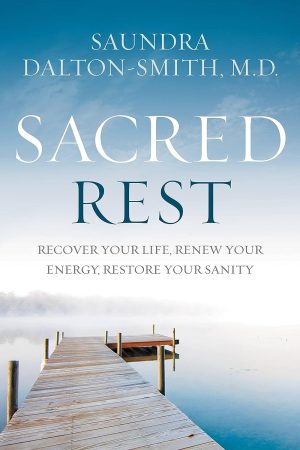Managing our schedules, balancing our workloads and navigating communication has only become more cumbersome — particularly post pandemic
However, our values and ways of working have shifted despite adhering to the same metrics and tools for success. With new tech developments threatening our personal and professional lifestyles, how can we ensure that we avoid feeling burnt out or disassociated? And instead feel satisfied with the output we produce, content with how we lead our lives?
In 2017, physician Dr Saundra Dalton-Smith released Sacred Rest: Recover Your Life, Renew Your Energy, Restore Your Sanity, a book suggesting that adults need seven types of rest — spanning physical, mental, emotional, social, sensory, creative and spiritual — to feel topped up. In a world striving to return to (and trump) pre-pandemic levels of performance, it’s little wonder the advice in this book is enjoying something of a revival.
Pinpointing energy drains
We’re living in a period of great dissatisfaction, while collectively yearning for more. In the UK at least, the last three years have uprooted the workforce, not just with the aftermath of the pandemic or the effect of Brexit, but the current over-inflated economy has toyed with our rents, our food prices and our bills. Basically, it’s exhausting just existing today and sometimes it can feel impossible knowing how to regain motivation and cultivate balance. Naturally, this has led many to reassess what’s important to them professionally, resulting in a re-prioritisation of values. We’ve had the great resignation, where people boldly quit their jobs; The London exodus, where they fled London for the calmer countryside (thanks to opportunities made possible by remote working); and most recently, quiet quitting, where workers held back the amount of energy they gave to their employers, effectively checking out from their job responsibilities.
In short, people are not happy with their set-ups and they are actively making changes.
While workers re-prioritise their wellbeing and sense of self-worth, Dalton’s concept offers a more nuanced approach to rest. Sure, we know some of the basic ‘rules’ for resetting ourselves — getting enough sleep, eating a balanced diet, going on holiday, limiting the amount of time we interact with tech etc — but understanding the cause and effect behind what drains energy is vital to avoiding it in future.
Redefining rest in seven steps
Dalton’s theory provides a framework for individuals wanting to be less governed by job pressures, who want more time for themselves and space to think. Her book outlines how categorising and clarifying different types of rest makes it easier for individuals to understand how to address an imbalance. Though the approach may feel targeted and strategic, it can be applied across personal and professional endeavours, across relationships and to health — providing a holistic assessment of the different areas in our lives to allow for more personalised readjustments.
For Dalton, rest equates to restoration across each of these key seven focus points. Naturally, Physical Rest recuperates the brain’s function but she believes it can take a passive or active form; with activities like sleeping and napping fitting the passive label, while yoga, stretching and massaging are actively-managed. Mental Rest refers to setting up systems that allow the brain to switch off so it’s not constantly bubbling over with thoughts, appointments or commitments — Dalton suggests scheduling short breaks every two hours to slow down thinking and jotting ideas down. Apps like BeFocused and Notion can be useful for keeping track and long-term, clearing the mind so it can focus on specific tasks at a time.
Emotional and Social Rest are linked and require similar awareness — with emotional rest encouraging individuals to authentically express themselves and feel free from judgemental interactions, while social rest asks that individuals surround themselves with uplifting relationships rather than ones that are demanding and exhausting — this awareness can be rolled out across personal and professional relationships.
Dalton refers to Sensory Rest as the reduction of digital stimulation. The stress that bright lights, computer screens and loud conversations put on the body is paramount. She encourages exercises like closing eyes or frequently unplugging electronics to avoid feeling over-stimulated. While Creative Rest and consciously pursuing inspiration outside of the workspace, whether in nature, art, or literature is equally important. Finding moments away from the grind is necessary for nourishing creative learning and feeling recharged.
Spiritual Rest is the final pillar in Dalton’s theory. She sees the value in getting individuals to do things beyond themselves and shifting perspective. Her suggested activities include prayer, meditation or community involvement, or engaging with religion.
Rest in the workplace
This list may seem prescriptive, but the identification of different types of rest acts as a guide for individuals to refer back to when lacking purpose or intention, in life and at work. Reviewing these categories can troubleshoot which areas need addressing and help with applying a more holistic approach — which has never been a more popular focus. But is it solely on individuals to understand their bodily resets, or do organisations increasingly have a part to play? As the job market becomes more competitive, prospective employees want jobs that align with their purpose and interests, or ones that come with an internal culture that resonates. Prior to the pandemic, a suitable in-house culture at a creative business would mean pool tables and Friday night drinks. But post pandemic, this now equates to greater flexibility and being able to work from home.
For employers, understanding the worth of Dalton’s scale is invaluable, and means they can work towards better management and improving job expectations, including navigating office dynamics. ChatGPT and AI assistance can be wonderful tools for automating processes and creating structural support, while mentors and coaches can support change, coordinate strategy, improve goal setting, oversee performance management and negotiate people skills. And the flux of lifestyle influencers and wellbeing businesses makes finding someone suitable even easier. Businesses that consciously promote wellbeing cultivate a sense that they care for their employees and are ultimately more empathetic to their circumstances… which makes for a happier workplace. Whether implemented on a collective or individual basis, Dalton’s book helps with figuring out what needs changing.
Rest isn’t something that’s traditionally championed at work. We associate work as a place of production and efficiency, but in a world increasingly paralysed by anxiety, poor mental health and unpredictable economic conditions, businesses have had to adjust to keep up with their employees. Mental health days have become normalised, HR departments are now more accountable and vigilant of office culture and the pressure to look after employees is higher than ever before with company away days and activities organised to encourage team bonding.
Dalton’s categorisation of rest provides an alternative way of thinking about how individuals reset — which is something that can also be promoted at company level. Businesses that have this embedded at their core and don’t shy away from incorporating personal wellbeing within a professional setting will appeal more with employees, and likely get the best from their workforce.
Featured image: Godisable Jacob / Pexels
































